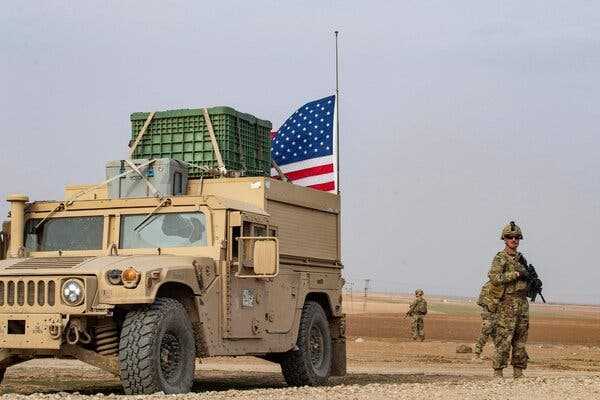The operations were the second time in recent weeks that U.S. forces had killed or captured ISIS terrorists.
-
Send any friend a story
As a subscriber, you have “>10 gift articles to give each month. Anyone can read what you share.
Give this articleGive this articleGive this article

U.S. forces patrolling in northern Syria on Thursday near a rehabilitation center for the children of suspected Islamic State members.
WASHINGTON — For the second time in just over a week, U.S. Special Operations forces carried out helicopter raids against the Islamic State in eastern Syria, this time capturing six operatives including a senior official who the military said was involved in plotting and enabling terrorist attacks.
The Pentagon’s Central Command, which oversees U.S. troops in Syria, said in a statement on Tuesday that the main target of three pre-dawn raids over the past 48 hours was a senior Islamic State Syria provincial official known by the nom de guerre al-Zubaydi.
Last Sunday, helicopter-borne American commandos swooped in on another ISIS official, known as Anas, killing him and an associate in a nearly three-hour gun battle in eastern Syria, the military said.
In this week’s assault, personnel from the Kurdish-led Syrian Democratic Forces, or S.D.F., the American counterterrorism partner in northeastern Syria, accompanied the U.S. troops, the military said.
“These partnered operations reaffirm Centcom’s steadfast commitment to the region and the enduring defeat of ISIS,” Gen. Michael E. Kurilla, the head of the command, said in a statement. “The capture of these ISIS operatives will disrupt the terrorist organization’s ability to further plot and carry out destabilizing attacks.”
More on U.S. Armed Forces
- Defense Bill: Congress passed a $858 billion defense bill that would rescind the coronavirus vaccine mandate for troops and increase the defense budget $45 billion over President Biden’s request.
- Abortion: The Pentagon is seeking to reassure service members worried about having access to abortions in states where the procedure is banned with travel funds and other support.
- J.R.O.T.C. Enrollment: In high schools across the country, students are being placed in military classes without electing them on their own.
- Navy SEAL Recruitment: The high failure rate of the elite force’s selection course shunts hundreds of candidates into low-skilled jobs.
No Americans were injured in the raids, officials said. An initial assessment indicated that no civilians were killed or injured, the military statement said.
The fact that the Pentagon sent commandos to kill or capture the Islamic State officials, rather than use a less risky drone operation, indicated their significance.
The United States has worked for years with the Syrian Democratic Forces to fight the Islamic State in Syria, and several hundred U.S. forces remain in territory the group controls in northeastern Syria near the Turkish border.
But that partnership has enraged Turkey, a U.S. ally and member of NATO, which views Syria’s Kurdish fighters as part of the Kurdistan Workers’ Party. The group has fought a bloody, decades-long insurgency against the Turkish state aimed at gaining independence or greater autonomy. Turkey, the European Union and the United States consider the insurgent group, known as the P.K.K., a terrorist organization.
President Recep Tayyip Erdogan of Turkey has started a series of airstrikes against Kurdish militants in northern Syria in recent weeks and warned that a ground operation will soon follow.
The S.D.F. briefly suspended the joint counterterrorism operation with the United States, suspecting an imminent Turkish attack. Fearing the loss of their main counterterrorism partner in the region, American officials rushed to tamp down tensions, at least for the moment, and operations soon resumed.
The raids this month were the first major American counterterrorism operation in northeastern Syria since U.S. Special Operations forces carried out two strikes against ISIS in October that killed three senior figures responsible for arming and recruiting fighters and plotting attacks, according to American and Syrian Kurdish officials.
Late last month, the Islamic State announced that its leader, whose identity has remained shrouded in mystery, had been killed in battle less than nine months after taking charge of the terrorist organization.
A Central Command spokesman confirmed in a statement soon after the ISIS announcement that the leader, Abu al-Hassan al-Hashemi al-Quraishi, had been killed in mid-October by anti-government rebels in southern Syria.
The two previous ISIS leaders were killed in separate raids by Special Operations forces on safe houses in northern Syria. The Islamic State also named a successor last month but provided no information about him other than a nom de guerre.
The leadership transition, announced through a voice message on Telegram, came at a time of extreme weakness for the group, which has been reduced in only a few years from the world’s most fearsome terrorist network to a low-level insurgency struggling to maintain its relevance in mostly rural parts of countries torn by conflict.
Source: nytimes.com



